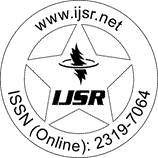Downloads: 3 | Views: 329 | Weekly Hits: ⮙1 | Monthly Hits: ⮙1
Case Studies | Pathology | India | Volume 12 Issue 6, June 2023 | Popularity: 5.1 / 10
An Unusual Presentation of Acute Lymphoblastic Leukemia as an Orbito-Sino Nasal Mass
I. V. Renuka, SK. Rizwana, B. Amulya, M. Atchyuta, I. V. Renuka, SK. Rizwana, B. Amulya, M. Atchyuta
Abstract: Introduction: Orbital extramedullary leukemic infiltration (termed ?orbital chloroma?) is an uncommon, but a well described manifestation of Acute Myeloid Leukemia (AML). However, such a presentation is infrequent in acute lymphoblastic Leukemia (ALL) with less than 25 cases described in the literature. We describe the clinico-radiological, haematological and histopathological characteristics of a child with proptosis, with an eventual diagnosis of ALL. We will be discussing the differential diagnosis and also review the relevant literature. Case Report: A 7-year-old girl, presented with progressive proptosis and vision loss in the right eye. CECT PNS showed infiltrative soft tissue masses in the bilateral orbits (right > left) with trans-osseous spread to the bilateral basi-frontal dura and right ethmoidal sinuses. Presence of trans-osseous spread without intervening bone destruction raised an imaging differential diagnosis of histiocytosis, lympho-reticular malignancy and metastatic neuroblastoma. Ultrasonography showed additional lesions in the pancreatic head and kidneys. Trans-nasal ethmoidal biopsy showed small round blue cells with scant cytoplasm, hence a possibility of non-Hodgkin?s lymphoma/Chloroma was considered. Immunohistochemical markers Neuron Specific Enolase (NSE), CD20 and Desmin were negative. Peripheral smear showed few atypical lymphocytes. Bone marrow aspiration showed rich cellularity with predominantly medium to large lymphoblasts with convoluted nuclei, 1 to 2 prominent nucleoli and scant basophilic cytoplasm, establishing a diagnosis of ALL-L2. Flow cytometry confirmed the diagnosis by CD38, CD19, HLA DR, CD22-Positive, CD34, CD20, CD7, CD56, CD2, CD36, CD64, CD 15, CD13, CD33, CD117, MPO, CD3 were negative. CD 10 was variable showing CALLA positivity (B cell lymphoblasticleukemia). Conclusion: Paediatric lymphoid orbital deposits ought to raise a suspicion of a systemic leukemia. Although AML is still the first differential in such cases, ALL should always be considered with a high index of suspicion owing to a significant difference in management.
Keywords: Acute Myeloid Leukemia, AML, Acute lymphoblastic leukemia (ALL), Immunohistochemistry-IHC
Edition: Volume 12 Issue 6, June 2023
Pages: 1846 - 1849
DOI: https://www.doi.org/10.21275/SR23607111038
Make Sure to Disable the Pop-Up Blocker of Web Browser
